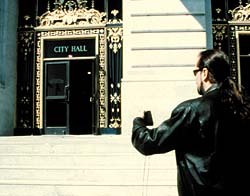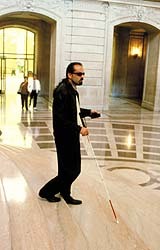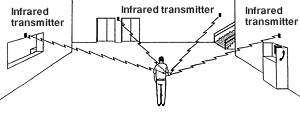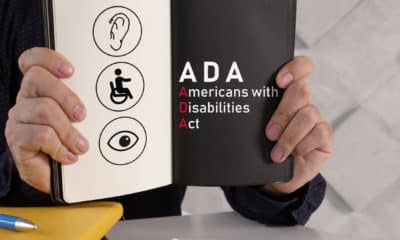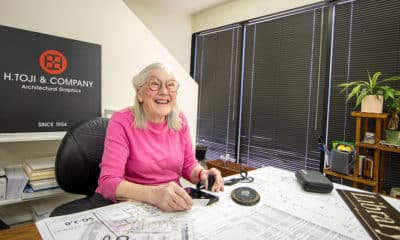ADA Signs
Signs of Independence
Talking Signs expand possibilities
Published
18 years agoon
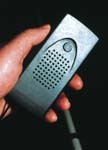
For visually impaired people, walking canes, guide dogs and Braille frequently fall short in the daily wayfinding challenge. None of these aids locates public facilities or tells the person when it’s safe to cross the street. Thus, people with visual handicaps frequently must depend on the assistance of strangers for mobility.
Although the Americans with Disabilities Act (ADA) mandates equal access to public transit and buildings, a recent survey found that, among working-age persons who cannot discern newsprint, nearly 75% are unemployed. Many blind citizens believe their personal dignity is too high a price to pay for mobility that other Americans take for granted. Although activists representing the visually impaired are familiar with this problem, they fight an uphill battle to encourage related research and development.
Sign language
In 1993, a technology originally developed by San Francisco’s Smith-Kettlewell Eye Research Institute was paired with ordinary directional, traffic and identification signage to provide a new level of personal independence. Talking Signs®, manufactured by Talking Signs Inc. (Baton Rouge, LA), enable visually-impaired persons to use signs and traffic signals as readily as people with normal vision.
Electronic transmitter units installed near signs and signals emit beams of infrared light coded with audible signage messages. Similar to a remote-control device for television, the transmitter incorporates a microchip carrying the sign’s message. The transmitter also incorporates LEDs that beam the sign’s message to a small, hand-held, wireless receiver (Fig. 1) carried by the visually impaired pedestrian. The brief message might say, for example, "Men’s restroom on the right," or "City Hall front entrance."
The transmitter emits tightly focused, infrared beams that can be adjusted according to the specific reception distance needed for a particular sign or signal (up to 150 ft. maximum outdoor range). Because the message beam is focused within a narrow spatial corridor, the hand-held receiver functions as a homing device, picking up a stronger signal when it’s pointed more directly toward the sign sending the message. Thus, sight-impaired users can precisely locate facilities like information desks, restrooms and ATM machines (Fig. 2).
Luminator Inc. (Plano, TX), a manu- facturer of electronic message signs used on public-transit buses, recently launched a new product that incorporates Talking Signs (Fig. 3). These new bus signs help visually impaired riders carrying receivers to identify arriving buses and hear destination or route information.
San Francisco story
Through the efforts of a progressive municipal government, San Francisco became the original laboratory for Talking Signs. Under its prototype program in 1993, the city’s Department of Parking and Traffic installed 14 Talking Signs at street crossings, 95 in the Bay Area Rapid Transit (BART) stations and 32 more in a local cultural center.
Street-corner signs tell pedestrians their present location (for example, "Fifth and Main, facing north"), while the status of corresponding traffic signals updates every five seconds via a message beam focused in the crosswalk area near the curb. In San Francisco’s Powell Street subway station, Talking Signs guide visually impaired riders to fare gates, boarding areas and exits. Since the initial rollout, Talking Signs have been installed in several other public facilities including San Francisco’s Municipal Railway (MUNI) stations, the Department of Public Works Building, the New Main Library, City Hall and the Civic Auditorium.
In the private sector, Bank of America installed Talking Signs at its San Francisco branch offices, and Outdoor Systems Inc. (Phoenix, AZ) uses talking signs in Bay-area bus shelters. In May 1999, the San Francisco Chronicle reported that approximately 900 Talking Signs had already been installed locally, bolstering San Francisco’s reputation as the nation’s most accessible city for visually impaired persons. Mayor Willie L. Brown Jr. is spearheading a program that uses private contributions to provide Talking Sign receivers to visually impaired residents.
Although awareness of Talking Signs technology is growing, few municipalities currently use these devices. Cost is one barrier because the current price of a transmitter unit is approximately $1,000. With the huge number of wayfinding signs in any major city, a large-scale program would be quite expensive. Until more signs are equipped with transmitters, however, demand for receivers (priced at $250) will be small. According to C. Ward Bond, president of Talking Signs Inc., "We’re trying to bring the chicken and the egg along at the same time."
But institutions for the blind in Austin (TX), New York, Boston and Glasgow, Scotland, already use Talking Signs. Public-transit stations in Washington, DC, and Venice, Italy, also use the technology. In August 1998, electronics giant Mitsubishi Precision Co. Ltd. (Tokyo) partnered with Talking Signs Inc. to manufacture and market the signs throughout the Far East.
Like the San Francisco model, future expansion of Talking Sign networks depends primarily on the determination of local municipal authorities to improve mobility and access for the visually impaired. But this technology also can assist travelers with normal vision. For example, Talking Signs could direct people standing outside a hotel entrance to local restaurants, or guide illiterate and dyslexic people. Many potential applications for this technology remain untapped.
Meaningful signs
Nowhere does the value of signs receive greater affirmation than in the comments of people who suddenly can use them for the first time. Jeane Adamson, a participant in a California study group evaluating Talking Signs, wrote, "For those few hours, I felt strong again, almost sighted, nearly normal. I never knew the transit center had a change machine or where the water fountain was. Thank you for that brief restoration of dignity, respect and independence."
Jerry Kuns of San Francisco, who has been blind since childhood, discussed what signage access means to him. "I travel all the time, and for me to go from here to Los Angeles, I probably have to ask and be handled by a dozen people. It’s demanding socially and psychologically." After using the Talking Signs system installed at San Francisco’s Powell Street BART station, Kuns remarked, "The independence and dignity provide me with a great deal more comfort and happiness. The freedom of choice is very important."
ST has emphasized the positive aspects of signage for many years, but Talking Signs technology establishes a new level of public service. What price can be placed on restoring human independence and dignity? What value can we ascribe to a technology that could ultimately help millions of capable individuals join the workforce? Furthermore, what medium is better equipped than signage to serve as the focal point for bringing visually impaired people into the social mainstream?
Blind activist Josh Miele of San Francisco doesn’t mince words on the subject. According to Miele, "Signs are the keys to our civilization. Imagine a world without signs and you’ll know what I’m talking about." You’re singing our tune, Josh.
| Additional Information |
For information about Talking Signs® wayfinding systems, contact the manufacturer at the following address: Talking Signs® |
| Talking Signs in Action |
Here’s a partial list of current and proposed installations: Austin, TX: Texas School for the Blind Boston: Carroll Center for the Blind Cincinnati: Children’s Museum Glasgow, Scotland: Glasgow Sight Center Mashantucket, CT: Pequot Museum New York: New York Lighthouse San Francisco: * Bay Area Rapid Transit (BART) Venice, Italy: Venice-Mestre Rail Station Yokohama, Japan: Raport Center |
SPONSORED VIDEO
Introducing the Sign Industry Podcast
The Sign Industry Podcast is a platform for every sign person out there — from the old-timers who bent neon and hand-lettered boats to those venturing into new technologies — we want to get their stories out for everyone to hear. Come join us and listen to stories, learn tricks or techniques, and get insights of what’s to come. We are the world’s second oldest profession. The folks who started the world’s oldest profession needed a sign.
You may like
Advertisement
Subscribe

Magazine
Get the most important news
and business ideas from Signsofthetimes Magazine.
Advertisement
Most Popular
-

 Tip Sheet1 week ago
Tip Sheet1 week agoAlways Brand Yourself and Wear Fewer Hats — Two of April’s Sign Tips
-

 Photo Gallery2 days ago
Photo Gallery2 days ago30 Snapshots of the 2024 ISA Sign Expo
-

 Ask Signs of the Times4 days ago
Ask Signs of the Times4 days agoWhy Are Signs from Canva so Overloaded and Similar?
-

 Real Deal1 week ago
Real Deal1 week agoA Woman Sign Company Owner Confronts a Sexist Wholesaler
-

 Benchmarks6 days ago
Benchmarks6 days ago6 Sports Venue Signs Deserving a Standing Ovation
-

 Editor's Note2 weeks ago
Editor's Note2 weeks agoWhy We Still Need the Women in Signs Award
-

 Women in Signs1 week ago
Women in Signs1 week ago2024 Women in Signs: Megan Bradley
-

 Photo Gallery1 week ago
Photo Gallery1 week ago21 Larry Albright Plasma Globes, Crackle Tubes and More

